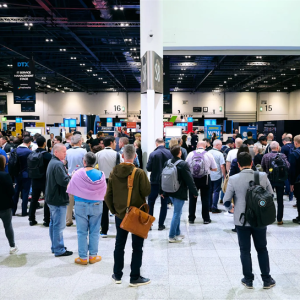
Identifying the right platforms to store and manage workloads has always been crucial to the efficiency and success of any organisation. Now in a time of flux – characterised by the emergence of artificial intelligence (AI), the growing prominence of edge computing, the impact of hybrid working patterns post-Covid, and the need to meet environmental sustainability commitments – the imperative has never been greater.

That’s why a growing number of enterprise organisations are looking at hybrid cloud as a means of managing disparate applications across a mix of private and public infrastructure. If hybrid presents a potential solution, what are the issues senior technology leaders need to consider prior to adoption? How, in other words, can they achieve the right balance with hybrid cloud?
To find out, Tech Monitor brought together a group of IT decision-makers for a roundtable discussion in London. The event – convened in association with Lenovo and VMware – took place in late January, with five key themes emerging from a lively conversation.
Hyperscalers: horses for courses
Three US-based providers dominate the public cloud market in the West. Collectively referred to as the hyperscalers, AWS, Microsoft Azure, and Google Cloud Platform (GCP) are effectively the public cloud market. An unscientific straw poll taken during the evening suggests that Microsoft Azure is the most popular choice among enterprise organisations, followed by AWS and Google Cloud. This may partly be down to sales and marketing – Microsoft has well-established enterprise relationships (“They are willing to sell Azure at a loss,” remarked one attendee.) Equally, it might also be down to the fact that Microsoft has a captive audience of Office 365 users conditioned to using SaaS (software as a service) solutions from Microsoft.
Finally, it may be because each hyperscaler has earned a reputation for a particular strength. Azure, for example, is known for web applications, while GCP’s perceived expertise lies in data management and AWS in technical build. “AWS knows how to attract techies,” one attendee quipped. “Microsoft knows how to sell to the business.”
Introducing polycloud
Unsurprisingly, most attendees were familiar with the concept of the hybrid cloud solution, insofar as it is an infrastructure approach that allows application workloads to draw on a mixed computing environment. Attendees were familiar, too, with the definition of multicloud, where an organisation is reliant on two or more public cloud providers for their computing services. Hybrid and multicloud are not mutually exclusive, of course, with many adopting both in unison.
The “polycloud,” however, proved new to most. A variation on the multicloud concept, polycloud allows organisations to draw on multiple public cloud providers and explicitly choose the most appropriate one for a particular project or aspect of a project.
To add a further layer of complexity, one business represented around the table is using a well-known public cloud provider both in a pure cloud environment and on-premise. The organisation in question – classified as critical national infrastructure – has specific security needs, physical as well as virtual. The cloud provider, meanwhile, doesn’t actively promote this mixed environment service but makes it available for exceptional use cases.
Managing up and the perils of ‘cloud first’
Several attendees observed how the drive to adopt public cloud services often comes from the top of the business. It is invariably the role of the technically literate to manage expectations and explain why a ‘cloud first’ approach – and especially a cloud-only approach – is not always the best option. Cloud undoubtedly offers elasticity that on-premise alternatives cannot but it can also cost significantly more over the long term. Said one attendee: “When my board decides that ‘we want to go 100% cloud’, I say: ‘Okay, but it will cost you three times as much.’”
Data storage and transfer fees (‘ingress’ and ‘egress’ charges as they are known) can be particularly prohibitive. As a result, our group of IT decision-makers urged caution. One, from a financial services organisation, said that, broadly speaking, he advises placing 20-30% of workloads into the public cloud; around 50% in the private cloud; and the remainder on-premise. As another attendee cautioned: “Public cloud still needs to mature and we need more people with specialist skillsets who know how to manage these clouds.”
When AI meets hybrid cloud
Artificial intelligence topped the list of topics attendees wanted to talk about – a finding which will come as little surprise to those exposed to online and in-person events over the last few months. Despite the hype, real-life applications are being explored. Most advanced are those in the productivity space. What, therefore, does the adoption of AI mean from a platform and infrastructure perspective? Where does it fit into a conversation about hybrid cloud? One attendee said that organisations faced three discrete options. Firstly, they could build an AI solution from scratch and to their own specifications. (“Good luck with that!,” he added, hinting at the likely cost and time involved). Secondly, they can take an existing AI model, apply their own data and train the application well. A third option might involve using an array of SaaS solutions, the makers of which are frantically adding AI-based features to their existing applications. Options two and three are the most realistic right now, he concluded.
Sustainability – moving down the agenda?
If AI is the flavour of the month, it appears it is so at the expense of environmental sustainability. Six months ago, the latter would have dominated a conversation such as this one. Has enterprise IT’s concern for sustainability therefore faded away? It depends on who you ask. Some are sceptical that green commitments were ever more than lip service. If the weight one gives environmental concerns during the tender process provides solid evidence of a serious commitment then, as one attendee said, it’s bad news for the planet. “It’s not there as much as it was,” the attendee said, referring to RFPs (requests for tender) that remain dominated by cost and performance measures at the expense of environmental factors.
Yet others were more bullish. “It still matters,” said another attendee referring to the weight her organisation gives to 2050 net zero targets. Asked if cloud – in all its guises – could help in the greening of IT, most attendees agreed that it could. Reducing hardware and limiting unnecessary consumption means the cloud remains as relevant as ever.
‘Achieving the right balance with hybrid cloud ’ – a Tech Monitor roundtable discussion in association with Lenovo and VMware – took place on 31 January 2024 at the Ivy Market Grill, London.







